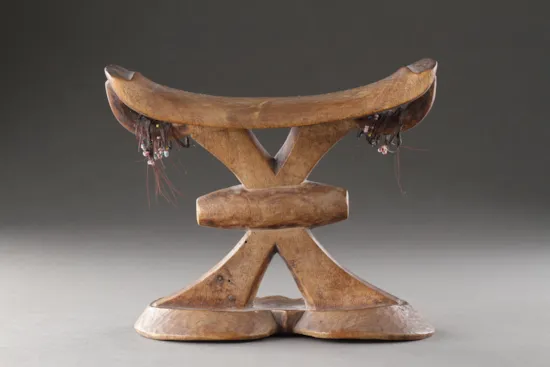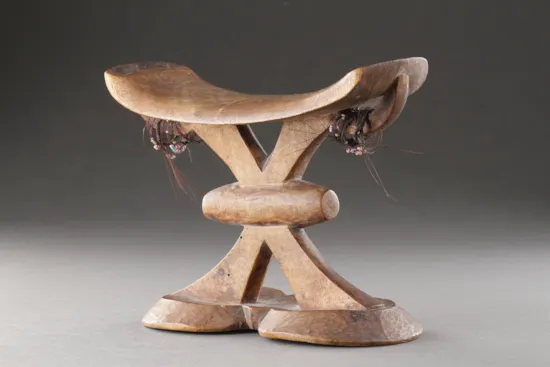A Fine ‘Old Dry’ South African Headrest Shona / Tsonga
A Fine ‘Old Dry’ South African Headrest Shona / Tsonga
The two lugs to the underside with animal (Giraffe ?) hair and glass beads attached
The ‘X’ section divided by an horizontal barrel
Old dry patina, a deeper colour to the extremities of the upper surface
Wood, hair, glass beads
South Africa
19th Century
SIZE: 14cm high, 17cm wide, 9.5cm deep - 5½ ins high, 6¾ ins wide, 3¾ ins deep
The two lugs to the underside with animal (Giraffe ?) hair and glass beads attached
The ‘X’ section divided by an horizontal barrel
Old dry patina, a deeper colour to the extremities of the upper surface
Wood, hair, glass beads
South Africa
19th Century
SIZE: 14cm high, 17cm wide, 9.5cm deep - 5½ ins high, 6¾ ins wide, 3¾ ins deep
A Fine ‘Old Dry’ South African Headrest Shona / Tsonga
The two lugs to the underside with animal (Giraffe ?) hair and glass beads attached
The ‘X’ section divided by an horizontal barrel
Old dry patina, a deeper colour to the extremities of the upper surface
Wood, hair, glass beads
South Africa
19th Century
SIZE: 14cm high, 17cm wide, 9.5cm deep - 5½ ins high, 6¾ ins wide, 3¾ ins deep
The two lugs to the underside with animal (Giraffe ?) hair and glass beads attached
The ‘X’ section divided by an horizontal barrel
Old dry patina, a deeper colour to the extremities of the upper surface
Wood, hair, glass beads
South Africa
19th Century
SIZE: 14cm high, 17cm wide, 9.5cm deep - 5½ ins high, 6¾ ins wide, 3¾ ins deep
The carvers of South African headrests were always male, but not necessarily specialist craftsmen. As H.P Junod states ‘many carved their own sticks, spoons, snuff boxes, and above all wooden pillows or headrests’ (H.P Junod ‘The Arts and Crafts of North Eastern Tribes of South Africa’. 1958 pg. 77)
Headrests were personal items for private use and were not made for public display. They were not indicators of status or rank, or used at communal events, but over time would become one with their owner, changing with their life as they became imbued with their spirit and were oiled and polished by their owners hair and body. The headrest was therefore regarded as an integral part of its owner and upon death was often buried with him.
However, sometimes headrests were kept as a way of establishing a bond between the living and their ancestors. One dreamt of them when sleeping on their former pillow: ‘the support of dreams’.
Headrests were personal items for private use and were not made for public display. They were not indicators of status or rank, or used at communal events, but over time would become one with their owner, changing with their life as they became imbued with their spirit and were oiled and polished by their owners hair and body. The headrest was therefore regarded as an integral part of its owner and upon death was often buried with him.
However, sometimes headrests were kept as a way of establishing a bond between the living and their ancestors. One dreamt of them when sleeping on their former pillow: ‘the support of dreams’.
Ex Private collection Edric Van Vredenburgh, published no. 205, vol 2, EVV collection catalogue 2014
Purchased Colin Gross, Portobello Road, London 1970’s
Purchased Colin Gross, Portobello Road, London 1970’s
A Fine ‘Old Dry’ South African Headrest Shona / Tsonga

SOLD
















YOU MAY ALSO LIKE



